Onboarding Welcome Letter
[Your Company Logo]
[Company Name]
[Address]
[City, State, ZIP]
[Phone Number]
[Email Address]
[Website]
[Date]
Dear [Employee's Name],
Welcome to [Company Name]! We are thrilled to have you join our team and embark on this exciting journey together. As you step into your new role, we want to extend our warmest welcome and provide you with some essential information to help you settle in smoothly.
Our mission at [Company Name] is [Briefly describe the company's mission and values]. We believe that your skills, talents, and expertise will play a crucial role in helping us achieve our goals and make a positive impact on [industry/sector].
Your Position and Responsibilities:
As a [Job Title], your responsibilities will include [Briefly outline key responsibilities and tasks]. Your role is essential to our success, and we are confident that your contributions will make a significant difference.
Your Team and Colleagues:
You will be working closely with a talented group of individuals who are dedicated to excellence in their respective fields. Our company culture is built on collaboration, open communication, and a shared commitment to achieving great results. Please don't hesitate to reach out to your colleagues for support and guidance as you settle into your role.
First-Day Instructions:
Your first day at [Company Name] is scheduled for [Date]. Here's what you can expect on your first day:
- Report to [Location/Department] at [Time].
- Meet with [Name], who will be your [Position/Title], to go over your onboarding schedule and answer any initial questions.
- Complete necessary paperwork, including [List any required forms or documents].
- Get familiar with our office space, facilities, and any relevant tools or systems.
- Attend a welcome session to learn more about our company culture, mission, and values.
Benefits and Perks:
At [Company Name], we value our employees and strive to provide a supportive and rewarding work environment. You will have access to a range of benefits, including [Briefly mention benefits such as health insurance, retirement plans, flexible work arrangements, etc.].
Contact Information:
If you have any questions or need assistance before your first day, please feel free to contact [HR Contact Name] at [HR Contact Email] or [HR Contact Phone Number].
Once again, welcome to the [Company Name] family! We are excited to have you on board and look forward to achieving great things together.
Sincerely,
[Your Name]
[Your Title]
[Department]
[Contact Information]
[Company Logo]
Note: This is a general template for an onboarding welcome letter. Make sure to customize it according to your company's specific details, culture, and policies.
Formal Onboarding Welcome Letter
Subject: Welcome to [Company Name]!
Dear [Employee Name],
On behalf of everyone at [Company Name], I would like to extend a warm welcome to you. We are delighted to have you join our team as [Job Title]. Your skills, experience, and enthusiasm are highly valued, and we are confident you will make significant contributions to our organization.
Your first day will be on [Start Date]. Please report to [Location/Department] by [Time]. Our HR team will guide you through the onboarding process, including orientation, introductions, and the setup of your workspace and accounts. Enclosed with this letter are details about your training schedule, company policies, and key contacts.
We look forward to working with you and supporting your success at [Company Name].
Warm regards,
[Manager/HR Name]
Casual Welcome Email for New Employee
Subject: Welcome Aboard, [Employee Name]!
Hi [Employee Name],
We’re super excited to have you join the [Department/Team Name] family! Starting a new job can be a mix of nerves and excitement, but don’t worry—we’re here to make sure you feel at home from day one.
Your first day is [Start Date], and we’ll kick things off with a team breakfast at [Location]. You’ll also get a tour of the office, meet your teammates, and settle into your role. We believe you’ll do great things here, and we’re thrilled to see your journey unfold.
Welcome to the team!
Cheers,
[Manager/Team Lead]
Heartfelt Onboarding Welcome Letter
Subject: We’re So Glad You’re Here!
Dear [Employee Name],
It gives me great pleasure to welcome you to the [Company Name] family. Your decision to join us is truly appreciated, and I want you to know that your role here matters. Every member of our team contributes to our shared success, and I am excited to see how your talents and perspective will enrich our culture.
Beginning on [Start Date], you will embark on a journey with us where growth, learning, and collaboration are at the heart of everything we do. You will have the support of your colleagues and leaders every step of the way.
Once again, welcome aboard—we are so fortunate to have you.
Sincerely,
[Manager/Director Name]
Team Introduction Welcome Message
Subject: Meet Your New Team!
Hello [Employee Name],
Welcome to [Company Name]! We’re thrilled that you’ll be joining us in the [Job Title] role. Our team is excited to work with you, and we’ve already planned some fun introductions so you can get to know everyone.
On your first day, we’ll have a quick meet-and-greet followed by a team lunch. You’ll also be paired with a “buddy” who will help you navigate your first few weeks and answer any questions you may have.
We can’t wait to get to know you better and start working together.
Best,
[Team Manager]
Simple Welcome Note for Remote Employee
Subject: Welcome to [Company Name]!
Dear [Employee Name],
Welcome aboard! We are excited to have you join our remote team as [Job Title]. Even though we may be working from different locations, you will quickly see how connected and collaborative our team is.
On your first day, you’ll receive login details and links to our virtual orientation session. We’ll also schedule a video call to introduce you to the team and walk you through our communication tools.
We’re glad to have you with us and look forward to your contributions.
Regards,
[HR/Manager Name]
Creative Welcome Email
Subject: Ready to Start Your Adventure?
Hey [Employee Name],
Welcome aboard! Think of your journey at [Company Name] as an exciting adventure where every challenge is an opportunity to grow and every project is a chance to shine. We’re thrilled to have you as part of our crew!
Your onboarding begins on [Start Date]. Pack your enthusiasm and curiosity because you’ll be meeting awesome teammates, diving into exciting work, and exploring the values that make our company unique.
Let’s make this journey unforgettable!
Adventure awaits,
[Manager Name]
Official Welcome Letter from HR
Subject: Official Onboarding Welcome Letter
Dear [Employee Name],
We are pleased to officially welcome you to [Company Name]. You have been appointed to the role of [Job Title], effective [Start Date]. This letter serves to confirm your onboarding details and outline the steps you will take as you begin your employment with us.
Please arrive at [Time] on your first day at [Location]. Bring valid identification for HR processing, and be prepared to review our company handbook and compliance requirements. Your assigned HR coordinator will be your point of contact throughout the onboarding period.
We look forward to supporting you in your career at [Company Name].
Yours faithfully,
[HR Representative Name]
What is an onboarding welcome letter and why do you need it?
An onboarding welcome letter is a message sent to a new employee before or on their first day to introduce them to the company and make them feel valued.
It serves multiple purposes:
- Provides essential first-day information such as reporting time and location.
- Helps new hires feel comfortable, excited, and part of the team from the start.
- Reinforces company culture and professionalism.
Who should send the onboarding welcome letter?
The sender depends on the company structure and tone:
- HR representatives often send official welcome and orientation details.
- Direct managers may send a more personal and role-specific welcome.
- Executives sometimes send a short note for senior-level hires to emphasize importance.
- Teams can also send a group message to make the new hire feel included.
When should an onboarding welcome letter be sent?
The timing is critical for impact. Best practices include:
- A few days before the start date to reduce anxiety.
- On the first day to accompany orientation materials.
- After offer acceptance, as an early engagement message.
What are the requirements and prerequisites before writing the letter?
Before drafting the letter, ensure the following:
- Confirm the new hire’s official start date and role.
- Have orientation or onboarding schedules prepared.
- Collect the employee’s contact details for sending.
- Decide on the tone (formal, casual, creative) depending on company culture.
How should you write and send an onboarding welcome letter?
Steps include:
- Start with a warm greeting and clear subject line.
- Introduce the company and emphasize the employee’s importance.
- Share practical details like date, time, and location for the first day.
- Mention orientation, training, or buddy programs.
- Close with encouragement and excitement. The letter can be sent as a printed copy (for formal cases) or as an email/message (for quick communication).
Formatting guidelines for onboarding welcome letters
Key considerations:
- Keep it between 200–400 words for clarity and warmth.
- Use a professional but approachable tone.
- Break content into short paragraphs for readability.
- Include practical details without overwhelming the employee.
- Use “Letter” format for official or formal communication and “Email” for casual/team messages.
Common mistakes to avoid in onboarding welcome letters
- Sending the letter too late or after the employee has already started.
- Using generic language that feels impersonal.
- Overloading the letter with policies or technical details better suited for orientation manuals.
- Forgetting to mention first-day basics like start time or contact person.
- Using a tone that doesn’t align with company culture.
Tricks and tips for making onboarding welcome letters more effective
- Personalize with the employee’s name, role, and team details.
- Highlight company values to introduce culture early.
- Pair the letter with a small welcome gift or digital resource pack.
- Involve the team by adding a short “welcome note” from colleagues.
- Keep the message positive, motivating, and clear.
Pros and cons of sending an onboarding welcome letter
Pros:
- Creates a strong first impression.
- Reduces new hire stress and confusion.
- Strengthens employee engagement from day one.
Cons:
- If poorly written, it can feel cold or generic.
- Overly detailed letters may overwhelm new hires.
- Requires coordination between HR and managers.

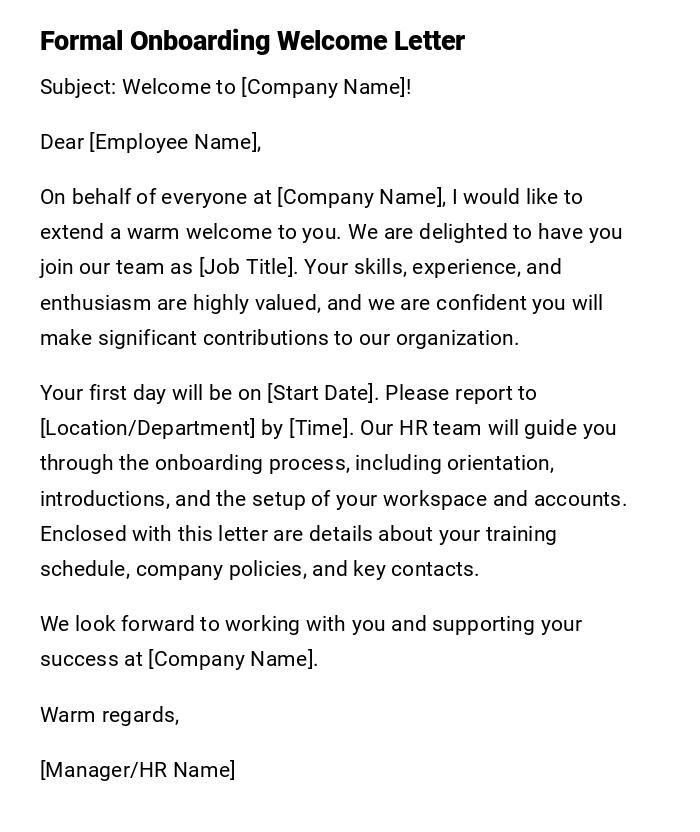
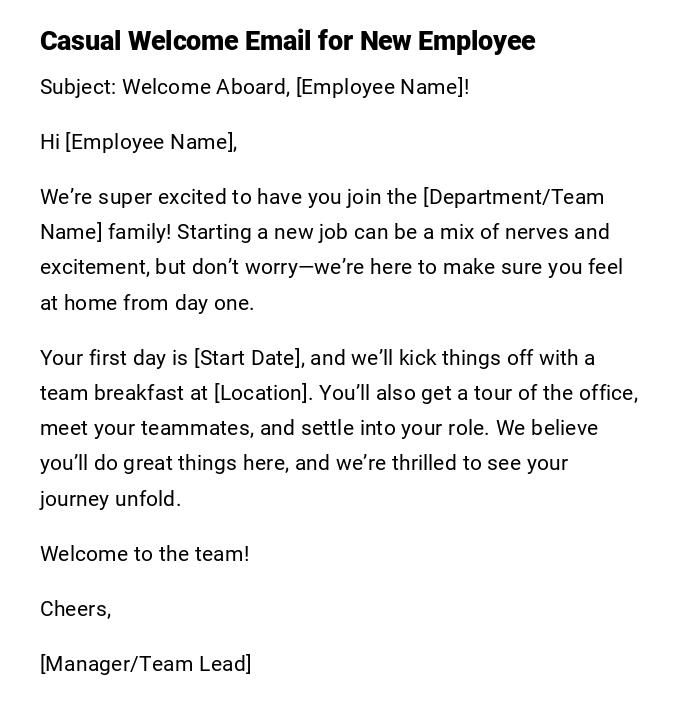
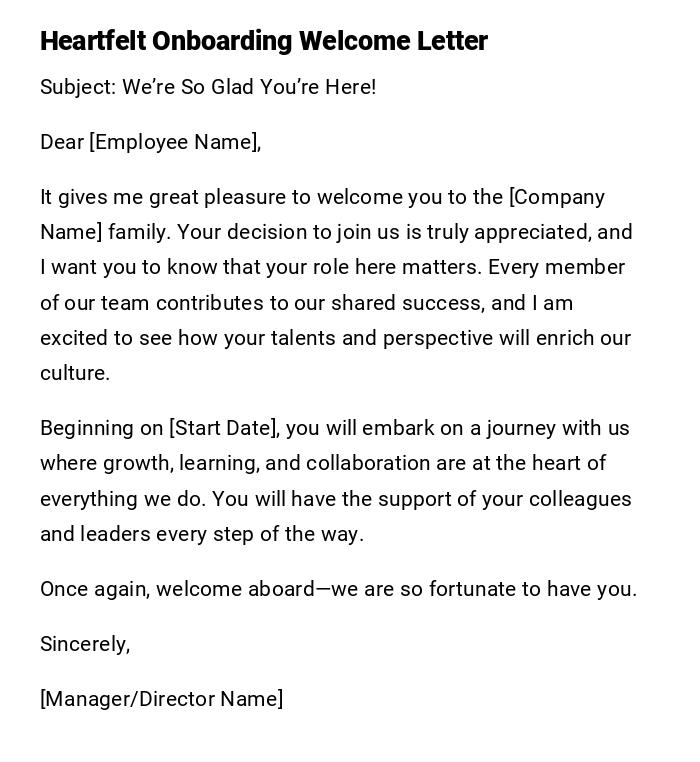
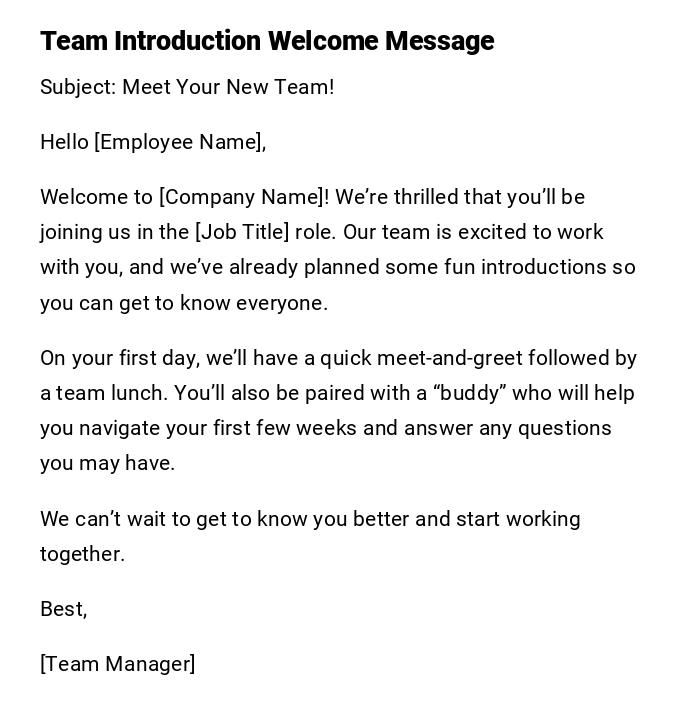
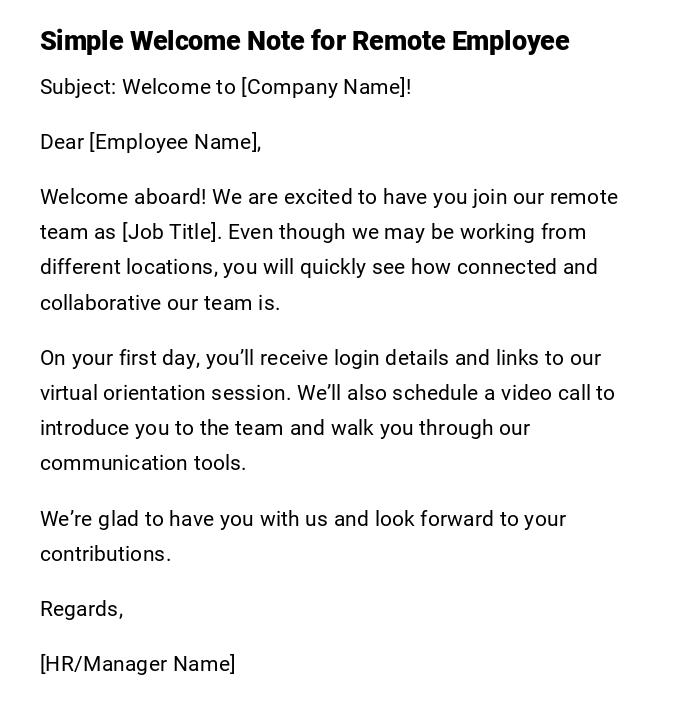
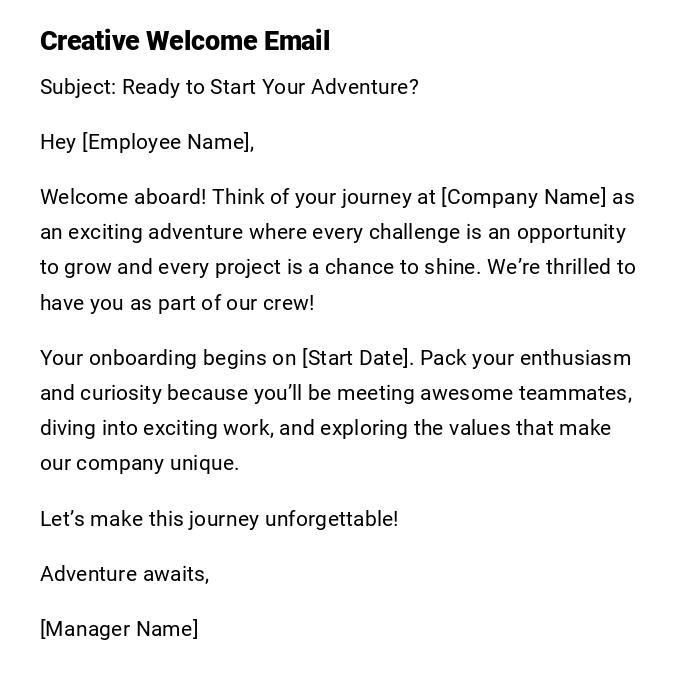
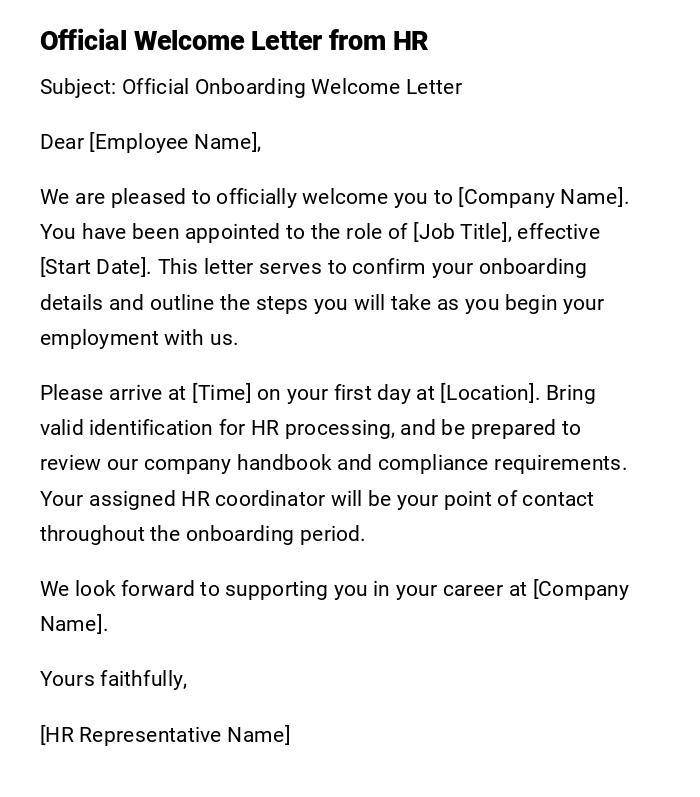

 Download Word Doc
Download Word Doc
 Download PDF
Download PDF